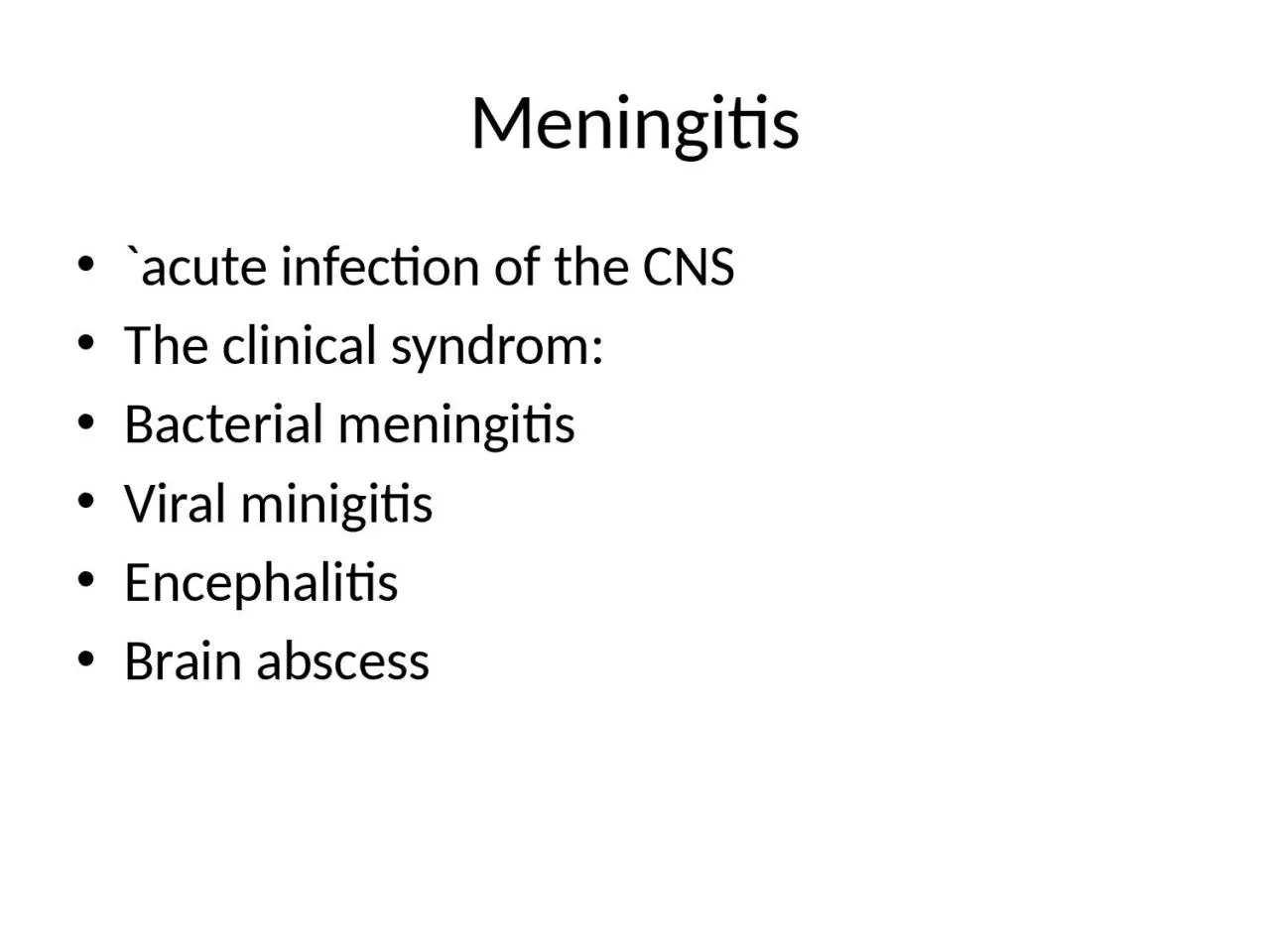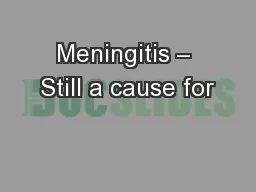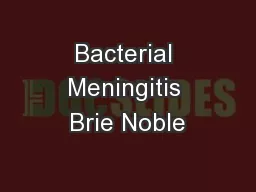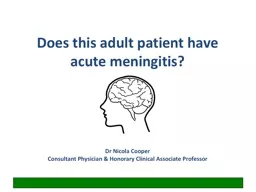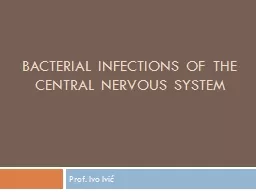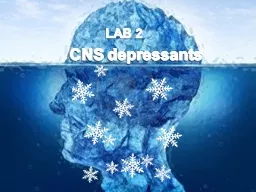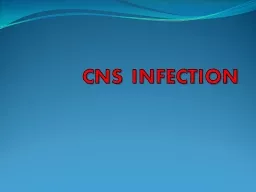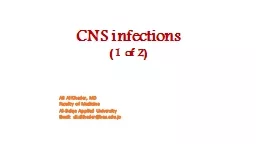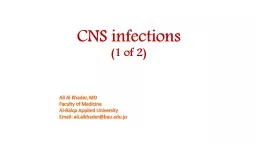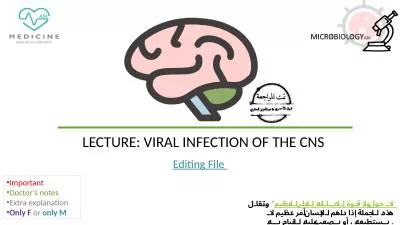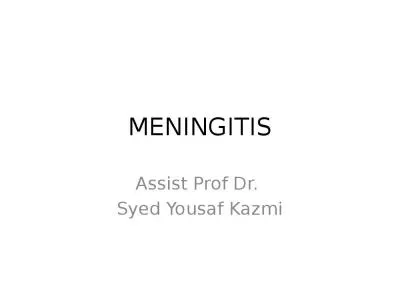PPT-Meningitis `acute infection of the CNS
Author : madeline | Published Date : 2024-03-13
The clinical syndrom Bacterial meningitis Viral minigitis Encephalitis Brain abscess Meningitis Acute infection within the subarchanoid space Bacterial Meningitis
Presentation Embed Code
Download Presentation
Download Presentation The PPT/PDF document "Meningitis `acute infection of the CNS" is the property of its rightful owner. Permission is granted to download and print the materials on this website for personal, non-commercial use only, and to display it on your personal computer provided you do not modify the materials and that you retain all copyright notices contained in the materials. By downloading content from our website, you accept the terms of this agreement.
Meningitis `acute infection of the CNS: Transcript
The clinical syndrom Bacterial meningitis Viral minigitis Encephalitis Brain abscess Meningitis Acute infection within the subarchanoid space Bacterial Meningitis Bacterial meningitis reflects . An Overview for Parents, Teachers, Students and Communities. 2013. Meningococcal Disease Fast Facts. Meningococcal disease is the result of a rare, but serious bacterial infection. It can occur as meningitis (inflammation of the lining of the brain and spinal cord), bacteremia (blood infection), or pneumonia. Video #1. http://. www.youtube.com/watch?v=h2-U1S74OH0. Video #2. http://. abcnews.go.com/Health/uc-santa-barbara-parents-meningitis-vaccine/story?id=21194093. What are the meninges?. The meninges are membranes that cover and protect the brain and spinal cord. The meninges consist of . concern. Protocols, vaccines, signs and symptoms, and . beyond. Susette Worgan-Brown. Information & Projects Co-. ordinator. Who we are. UK charity based in Stroud, Gloucestershire. Meningitis Trust and Meningitis UK merged in 2013. What is Meningitis?. Infection of the Meninges (membranes around the brain and spinal . cord). It . can be caused by bacteria, fungi or a . virus. Bacterial Meningitis is the most common, accounting for nearly “80% of all cases are acute bacterial meningitis. Does this adult patient have acute meningitis? Dr Nicola Cooper Consultant Physician & Honorary Clinical Associate Professor Scenario A 30-year-old woman was admitted to the Acute Medical Unit with a 48-hour history of gradual onset severe headache and fever of 38.5 Prof. . Ivo Ivić. CNS. Restricted. . space for expansion of the inflammatory edema. I. ncrease. . of. . intracranial. . pressure. Tissue. . infarction. . Neurological. . sequelae. Death. . located within the bony armor. LAB 2. Some Drugs That Effect CNS. Stimulants. Depressants. A . stimulant. is a drug that speeds up activities of the CNS. A . depressant. . is a. . drug that slows brain and body reactions. Stimulants increase. Meningitis. Encephalitis. Brain abscess. Transverse myelitis. MENINGITIS. Acute infection of the meninges presents with a characteristic combination of . Pyrexia. . Headache. . Meningism. . . Meningism. Faculty of Medicine. Al-Balqa Applied University. Email: ali.alkhader@bau.edu.jo. How can microbes enter the nervous system?. Hematogenous. …the most common. . …mostly arterial. . …can be from facial veins (through anastomoses with venous sinuses of the skull). Ali Al Khader, MD. Faculty of Medicine. Al-Balqa Applied University. Email: ali.alkhader@bau.edu.jo. We will discuss viral encephalitis and prion diseases . Viral encephalitis, general. A parenchymal . . Important. Doctor’s notes . Extra explanation. Only F . or . only M. Editing File . ". لا حول ولا قوة إلا بالله العلي العظيم. Inflammation of the brain cortex is called encephalitis. Meningismus. refers to meningeal irritation not due to CNS infection. Meningitis -overview . AETIOLOGY . Neonatal period. Syed Yousaf Kazmi. LEARNING OBJECTIVES. List . causes of acute and chronic meningitis. Discuss . pathogenesis of acute and chronic meningitis. Discuss . mechanism of transmission of pathogens . . causing . Dr. Sonalika’s Eye Clinic provide the best Eye infection treatment, Conjunctivitis treatment in pune, Hadapsar, Amanora, Magarpatta, Mundhwa, Kharadi Rd, Viman Nagar, Wagholi, and Wadgaon Sheri
Download Document
Here is the link to download the presentation.
"Meningitis `acute infection of the CNS"The content belongs to its owner. You may download and print it for personal use, without modification, and keep all copyright notices. By downloading, you agree to these terms.
Related Documents

